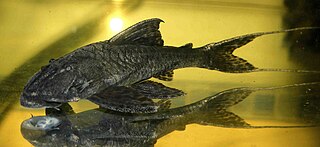
Loricariidae is the largest family of catfish, with 92 genera and just over 680 species. Loricariids originate from freshwater habitats of Costa Rica, Panama, and tropical and subtropical South America. These fish are noted for the bony plates covering their bodies and their suckermouths. Several genera are sold as "plecos", notably the suckermouth catfish, Hypostomus plecostomus, and are popular as aquarium fish.

Hypostomus is a genus of catfish in the family Loricariidae. They are native to tropical and subtropical South America. H. plecostomus is the popular freshwater aquarium fish formerly known as Plecostomus plecostomus. There is a lot of confusion as to the precise taxonomic structure of the Loricariidae.

Acanthicus is a genus of large, South American suckermouth armored catfishes native to the Amazon and Orinoco basins, and possibly in Guyana. The name Acanthicus is derived from the Greek, akanthikos meaning thorny, spiny. Fish of this genus are known as lyre-tail plecos. These species are found in large rivers, primarily in areas with a rocky bottom and a moderate or strong current.

Farlowella is a genus of fish in the family Loricariidae native to South America. This genus is broadly distributed in Amazon, Orinoco, Paraná and coastal rivers of the Guyana Shield. It is absent from the Pacific slope of the Andes and from the coastal rivers of the Brazilian Shield. Many of these species are kept in aquariums. This genus has a unique body shape that resembles a thin stick of wood. The body is slender and elongate, often with a pronounced rostrum and a brownish color with two lateral dark stripes beginning at the tip of the rostrum, passing over the eyes and ending at the tail, which are periodically interrupted on the caudal peduncle.

The Hypoptopomatinae are a subfamily of catfishes of the family Loricariidae, composed of 17 genera and approximately 80 species. This subfamily represents about one-tenth of all loricariid species.

Hypoptopoma is a genus of armored catfishes native to South America.
Nannoptopoma is a small genus of catfishes of the family Loricariidae. This genus includes two species, N. spectabile and N. sternoptychum.
Neoplecostominae is a subfamily of South American catfishes of the family Loricariidae. Species of this subfamily live in high-mountain and swift-flowing river habitats.

Parotocinclus is a genus of fish in the family Loricariidae native to South America. This genus is distributed through almost all hydrographic systems in South America from the Guyana Shield drainages and Amazon Shield tributaries to the coastal drainages of eastern and southeastern Brazil, including the rio São Francisco basin. Most species have the caudal peduncle oval in cross section. It has been found that Characidium species may interact with P. maculicauda. The small Characidium will follow grazing P. maculicauda, which release particulate matter dislodged from the catfish's foraging.
Hypoptopoma spectabile is a species of armoured catfish native to the Amazon and Orinoco river basins in Colombia, Ecuador, Peru and Venezuela. This species grows to a length of 2.9 centimetres (1.1 in) SL.
Hypoptopoma sternoptychum is a species of catfish of the family Loricariidae.
Panaque bathyphilus is an Amazonian species of armoured catfish from the family Loricariidae. The holotype of the species was collected in the Solimões river, upstream of its confluence with the Purus river. This species has been known in the aquarium trade, at least since 1992, as papa panaque and under the L-number code L090. It reaches up to about 40 cm (16 in) in length.

Peckoltia pankimpuju is a species of armored catfish from the family Loricariidae, native to the Marañón River in the upper Amazon basin of Peru. It is commonly called the coal pleco, Peruvian lyre-tail, and L350 under the L-number code. It reaches up to about 40 cm (16 in) in length.
Scott Allen Schaefer is an American ichthyologist working at the American Museum of Natural History as the Dean of Science for Collections, Exhibitions, and the Public Understanding of Science; he serves as the Curator-in-Charge, in the Department of Ichthyology, within the Division of Vertebrate Zoology.
Hypoptopoma baileyi is a species of catfish of the family Loricariidae.
Hypoptopoma bianale is a species of catfish of the family Loricariidae.
Hypoptopoma brevirostratum is a species of catfish of the family Loricariidae.
Hypoptopoma elongatum is a species of catfish of the family Loricariidae.
Hypoptopoma machadoi is a species of catfish of the family Loricariidae.
Hypoptopoma muzuspi is a species of catfish of the family Loricariidae.







